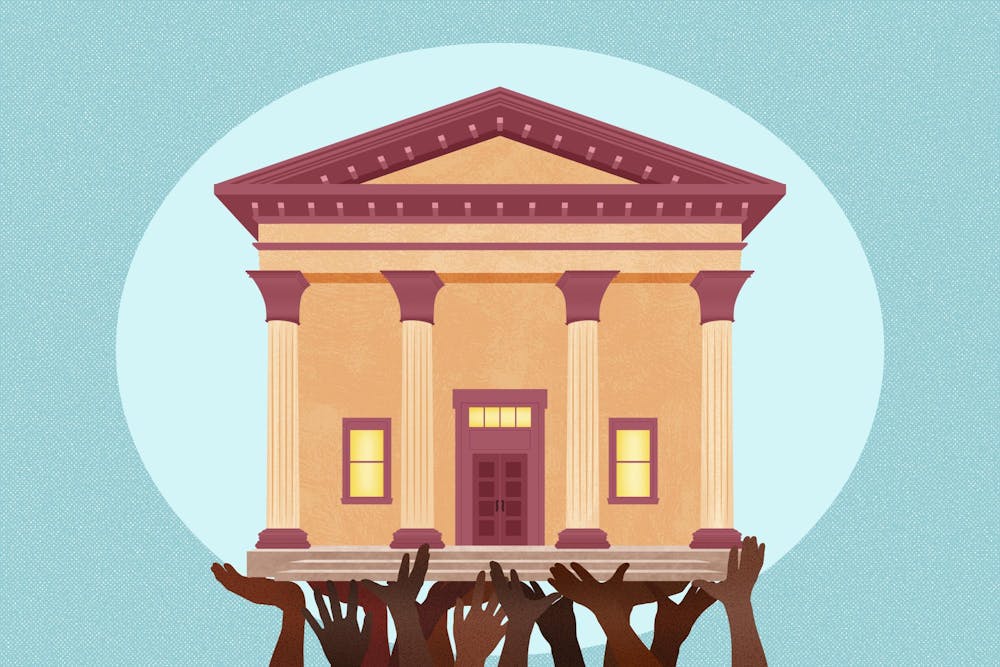The cabinetry in the newly constructed debate rooms was done by Thomas Day, a freed African American man. Albert, Osborne and Day worked side-by-side to give Old East the distinct character it still has today.
Early Romanticism was inspired by Greek Revival, a movement in the late 18th century and early 19th century, built on the ideals of liberty and democracy.
UNC, along with other universities across the United States, wanted to reflect these ideals in its architecture, because concepts of liberty and accessibility to education were treasured by University founders.
However, the University at its founding was inherently exclusionary, Sarah Carrier, a UNC research and instruction librarian, said.
Part of understanding the South involves understanding the mythology it crafted around itself, she said, which is inherent in the so-called great men that founded the University and present in various histories, such as Archibald Henderson’s 1949 book “The Campus of the First State University.” This version of history, however, is exclusive and white supremacist, she said.
“Nostalgia is very important in all of this and I think where the architecture comes from, but nostalgia for what?” she said. “I think that there is an intentional aesthetic cue for us to be nostalgic for very classical ideas and ways of living that create great men. And that's a very narrow idea.”
Carrier said this white supremacist messaging is inherent in UNC’s campus. While functional, she said, the original buildings that comprise UNC are monuments to people who fought for liberty in the American Revolution, but were all enslavers.
Joseph Jordan, a teaching associate professor and former director of the Sonja Haynes Stone Center for Black History and Culture, said that UNC’s buildings can be divided between what he calls the monumental campus and the vernacular campus.
For Jordan, the monumental campus comprises of the University’s original buildings, extending from McCorkle Place through Polk Place, and ending at Wilson Library.
One such prominent building is Memorial Hall, which includes the names and crypts of prominent figures in UNC’s past.
“That is a memorial site, and in a way you could argue that it is a call back or a reminiscence of white supremacy,” he said. “And, by the way, it does have to reckon with the fact that many of the people who are in there and on that wall were white supremacists, as were some of the people who are buried in Chapel Hill Cemetery on campus.”
The vernacular campus, on the other hand, consists of buildings that are meant to be temporary, he said, and are not considered historically valuable.
To get the day's news and headlines in your inbox each morning, sign up for our email newsletters.
Jordan was the director of the Stone Center at the time it was built by architect Phil Freelon, a project that launched Freelon’s architectural career focused solely on art, history and culture — particularly Black culture.
The Stone Center is inspired by African architecture, Jordan said, with imprints of African cloth decorating the inside of the building, and the columns on the outside of the building meant to recall the shape of African drums.
While some buildings should be preserved for their historical value, Jordan said, University planners need to be intentional with how they reflect on the history of certain buildings.
“We don’t want the University to stagnate because someone’s remembrance makes it impossible to take us to the next step, to progress to the next phase of history, looking at what’s here now, and what’s possible in the near future,” he said.
As a doctoral student at UNC, Caroline Wood Newhall collected data on enslaved African Americans and published her findings on "For the Record," a blog run by University Libraries. In 2018, Newhall published a list of names of enslaved laborers who built the University.
Newhall said that buildings can be re-memorialized to reestablish the full significance of the buildings: those that were constructed for education and democracy, and simultaneously ones that were constructed by enslaved African Americans.
“The South is a construction as much as anything, it's an idea, not necessarily a reality,” she said. “So having it be an identity is an ideal as much as anything, as much as being Northern.”
Bauer said architecture not only represents the past, but also how people can experience the past in the present.
“We are constantly learning about our predecessors,” she said. “We are looking at what they have done, how it affects us now, but also how maybe our values have changed over time and how, as we learn about those things, can we better express our own values?”
@morgan_mbrenner
@dthlifestyle | lifestyle@dailytarheel.com




